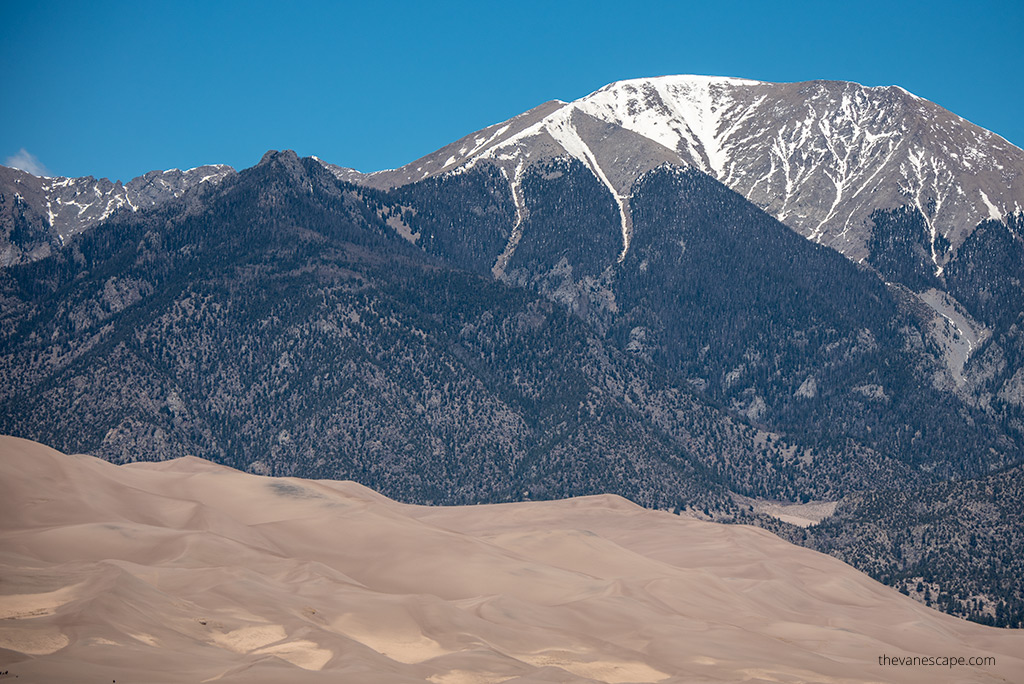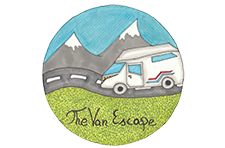15 Best Things To Do In Great Sand Dunes National Park
This list of the 15 Best Things To Do In Great Sand Dunes National Park will inspire you to a great adventure. Plan a trip to Great Sand Dunes National Park in Colorado? Check our tips on preparing to visit this unique and fabulous place, which protects the tallest dunes in North America. How to get there? Where to stay? What to Pack? And what are the 15 best things to do in Great Sand Dunes National Park? Check our Ultimate Guide to Great Sand Dunes.
This article may contain affiliate / compensated links. For full information, please see our disclaimer here.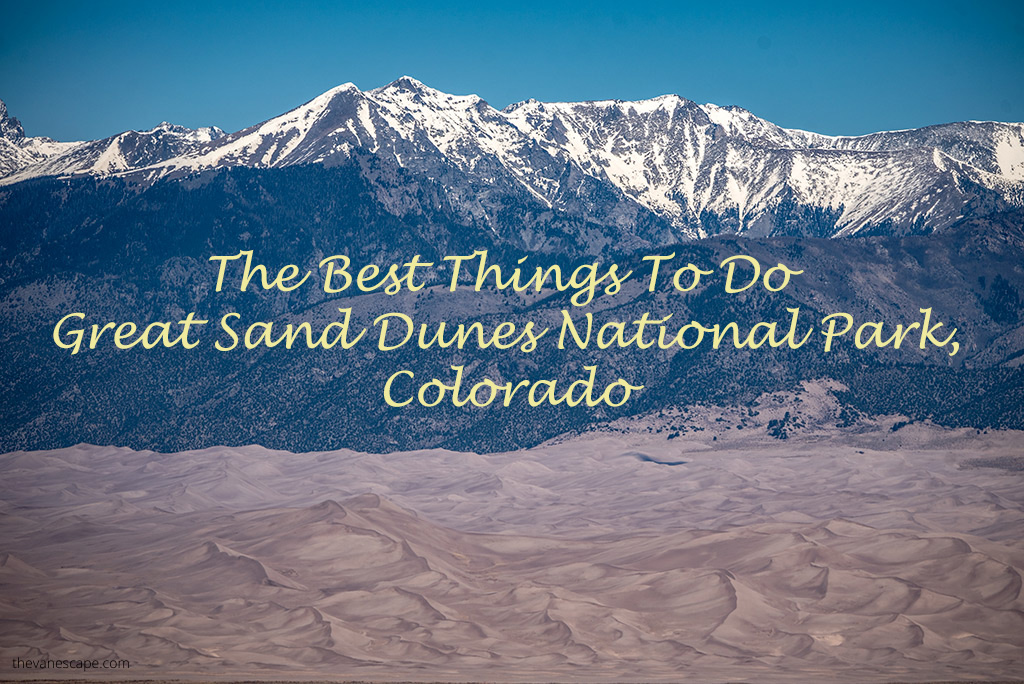
Where is Great Sand Dunes National Park and how to get there?
Great Sand Dunes National Park is located on the eastern edge of the San Luis Valley in south-central Colorado.
- From Alamosa, it is about 35 miles and 40 minutes to drive via US-160 E and CO-150 N.
- If you are driving from Colorado Springs, take I-25 S and US-160 W. It’s about 2 hours and 50 minutes and 168 miles.
- From Durango, take US-160 E. It’s 169 miles and takes approximately 3 hours and 20 minutes to drive.
- If you are driving from Mesa Verde National Park is 223 miles via US-160 W. It’s 4 hours 30 minutes of driving.
It’s important to know that it’s a pretty remote area. There won’t be many services. The nearest gas stations are in Mosca (23 miles west) or Fort Garland (31 miles southeast). So, prepare for your trip.
Chris and I explored this park during our 14-day Colorado road trip itinerary. We enjoyed the dunes and scenery. All pictures presented in this article were taken during this trip. We share our firsthand experience and tips on the top activities to do in this park.
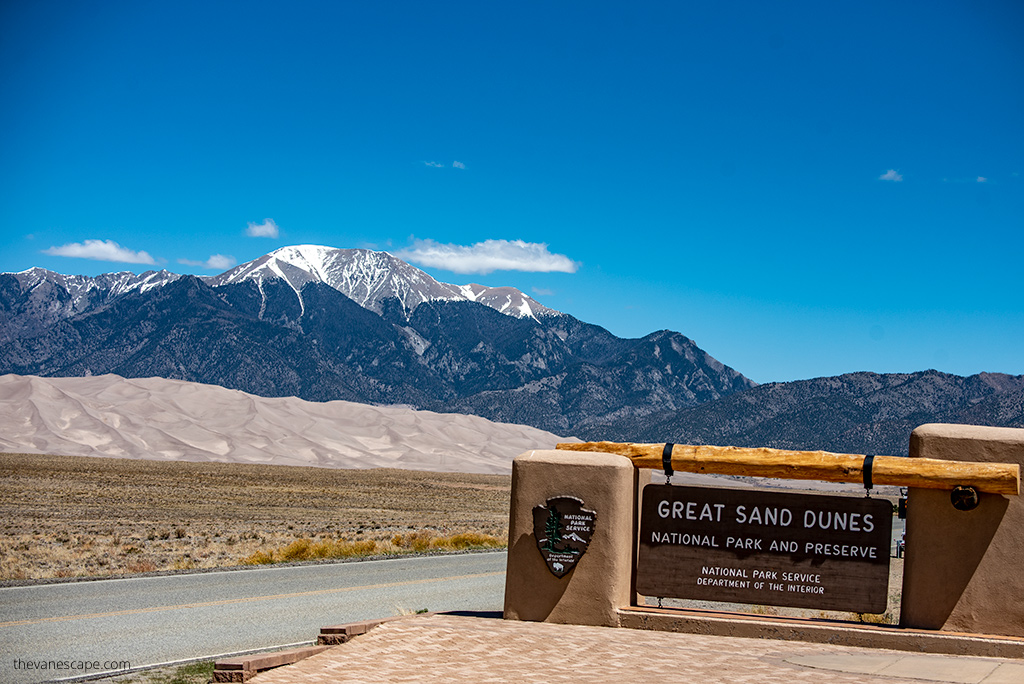
Interesting Facts about Great Sand Dunes National Park
The size and creation date
- Great Sand Dunes National Park contains the tallest dunes in North America.
- Great Sand Dunes National Park and Preserve conserves an area of large sand dunes up to 750 feet (229 m) tall.
- At 750 feet, Star Dune is the tallest dune in Great Sand Dunes National Park, followed by High Dune at 699 feet.
- The park was initially designated Great Sand Dunes National Monument on March 17, 1932, by President Herbert Hoover. As a national park, it was established on September 24, 2004, by George W. Bush.
- The Great Sand Dunes National Park encompasses 107,342 acres (167.7 sq mi; 434.4 km2). The park has one of the world’s most fragile and complex dune systems.
- The dunes cover an area of about 30 sq mi (78 km2) and are estimated to contain over 1.2 cubic miles (5 billion cubic meters) of sand.
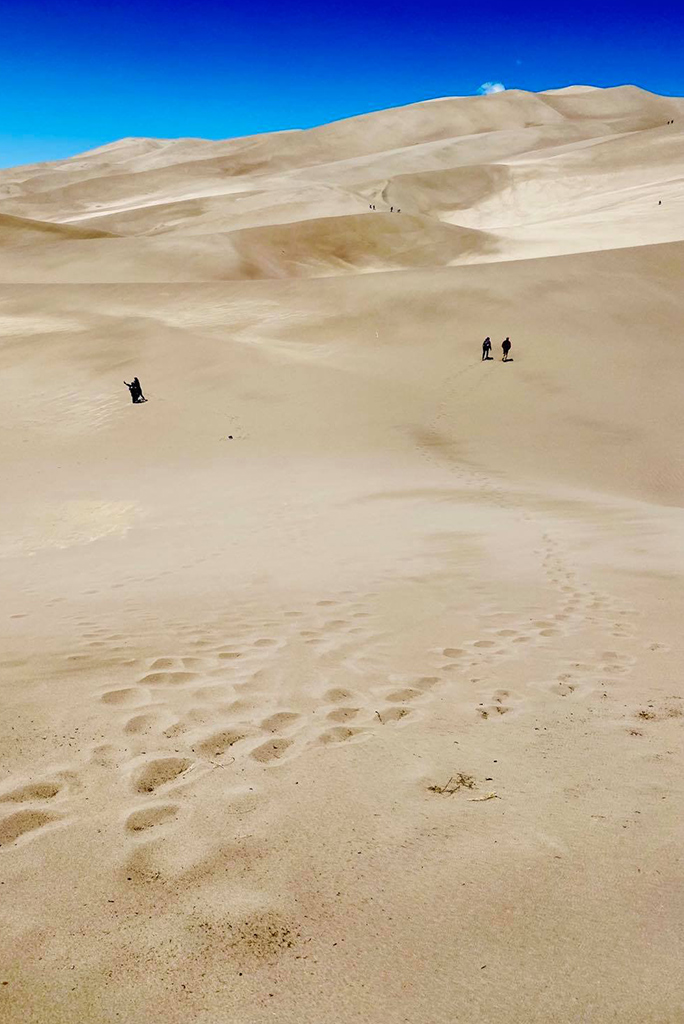

Elevationes, temperatures and wildlife
- Within Great Sand Dunes National Park & Preserve, there is an elevation change of 6084 feet. The lowest point in the park is 7520 feet near San Luis Lakes, and the highest point is Tijeras Peak, at 13,064 feet.
- Winds of up to 40 mph continually reshape the dunes.
- In the hot summer afternoons, the sand surface can reach 150°F.
- Moreover, the Great Sand Dunes National Park is home to a great diversity of plants and animals and at least six endemic insect species -found nowhere else on earth. One of them is Tiger Beetle.
- It’s also good to know that there are no snakes or scorpions in the dunes.
- Moreover, the park contains some of America’s oldest known archeological sites.
- The recreational visitor total was only 527,546 in 2019. So, it is one of the lesser visited national parks in the United States.
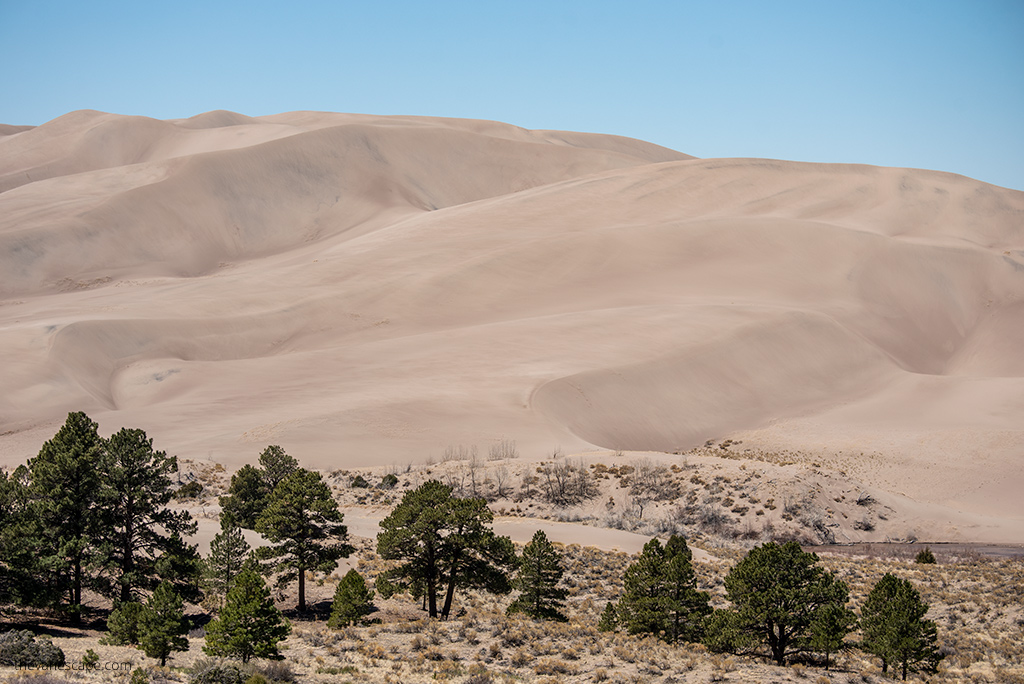
How Were the Sand Dunes Formed?
According to the NPS website, the Great Sand Dunes originated from large lakes that once covered the San Luis Valley portions.
Side-by-side, the Sangre de Cristo Mountains and the San Juan Mountains create a semicircular rim. Millions of years ago, water from the melting glaciers of these mountains flowed down into this pocket. In effect, Lake Alamosa was formed. The water washed sediment and sand into this basin.
Over time, the lake receded, leaving behind the sand. As the wind blows into this pocket, more sand accumulates, creating the dunes. During storms, the wind blows in the opposite direction, which causes the dunes to grow taller.
Medano Creek and Sand Creeks continue to bring sand from the mountains and deposit it at the dune field. You will find more information about the geology of the Great Sand Dunes National Park on the website.
Is Great Sand Dunes National Park worth seeing?
Great Sand Dunes National Park is one of four national parks in Colorado. It is an extraordinary and unique place on the country scale. The park offers an amazing ecosystem. They are sand dunes, wetlands, forests, alpine peaks, and wildlife. Moreover, there are some things to do in Great Sand Dunes National park which are impossible to do in other parks.
In our opinion, the Great Sand Dunes is an underestimated park that offers amazing attractions. In addition, the dramatic contrast of dunes against the background with the alpine peaks of the Sangre de Cristo Mountains makes this place extremely photogenic. Therefore it is undoubtedly worth adding it to your Colorado Road Trip Itinerary.
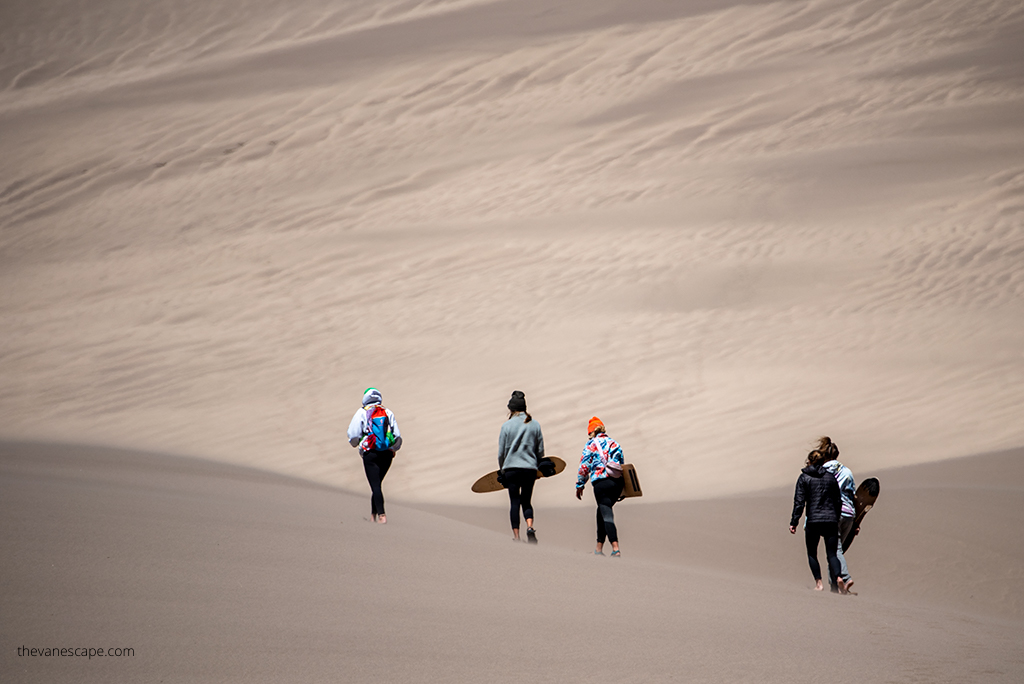
What is the best time to visit Great Sand Dunes National Park?
You can visit Great Sand Dunes National Park year-round, but the mildest weather will be late Spring and Fall. The best time to visit Great Sand Dunes depends on your priorities and activities plan. Before you go, check the weather.
The best time for photography at Great Sand Dunes National Park is early and late in the day when the shadows accentuate the contours of the dunes. It’s also a great idea to wait for the sunset.
Spring in Great Sand Dunes National Park
In Great Sand Dunes, March and April are the snowiest months of the year. But late April and May are great for a visit. Temperatures may vary widely from 60°F to the 30°F. We were in May, and the weather was fantastic. It was sunny but not too hot, perfect for hiking.
Summer in Great Sand Dunes National Park
Summer is hot in Great Sand Dunes National Park. But Summer air is pleasant with an elevation of 8200 feet. Daytime high temperatures average 75-80°F. However, sand surface temperatures can soar to 150°F(66°C) on sunny summer afternoons. That’s why you must prepare for this weather. Check our tips below on what to bring. In Summer, start your hike early in the morning.
Fall in Great Sand Dunes National Park
Fall is mild in the Great Sand Dunes. Highest average in the 60 – 70°F, with chilly nights in the 20 – 30°F. However, be prepared for the cold fall storm, bringing rain or even snow sometimes.
Winter in Great Sand Dunes National Park
Winter is sunny but cold. The average temperature is 30°F—low temperatures averaging minus 15°F to minus 5°F in the coldest part of winter. So, pack warm clothes for a winter visit to Great Sand Dunes National Park.
How much time do you need at Great Sand Dunes National Park?
You need at least half a day to see the main attractions of the Great Sand Dunes. It’s a pretty small park, and the list of best things to do in Great Sand Dunes is not too long. So, reserve 3-5 hours during your Colorado road trip to enjoy it.
But if you have more time, it is worth staying here for 1 or 2 days to enjoy this amazing scenery. Especially if you want to try activities like sandboarding and sand sledding on the dunes. The dunes look different at each time of the day. They shimmer in the colors of the sun.
Entrance Fees to Great Sand Dunes National Park
The Great Sand Dunes National Park and Preserve is open year-round.
The basic Entrance Pass (good for up to seven consecutive days) is $25 for a normal car. Oversized Vehicle, 15+ passengers, age 16+ (large van) is $15/person.
But if you plan to visit more national parks throughout the year, the best idea is to purchase Annual America the Beautiful Pass. It’s only $79.99 and is your ticket to more than 2,000 federal recreation sites across the country, including all national parks. The pass is valid for 1 year from the month of purchase. It covers entrance for a driver and all passengers in a personal vehicle at per-vehicle fee areas or up to 4 adults at sites that charge per person (kids 15 & under get in free)
To get actual information and see exhibitions and park stores with a wide selection of books, postcards, magnets, T-Shirts, and posters, it is worth visiting The Great Sand Dunes Visitor Center. The visitor center is open every day, year-round (except closed on Thanksgiving, Christmas, and New Year’s Day).
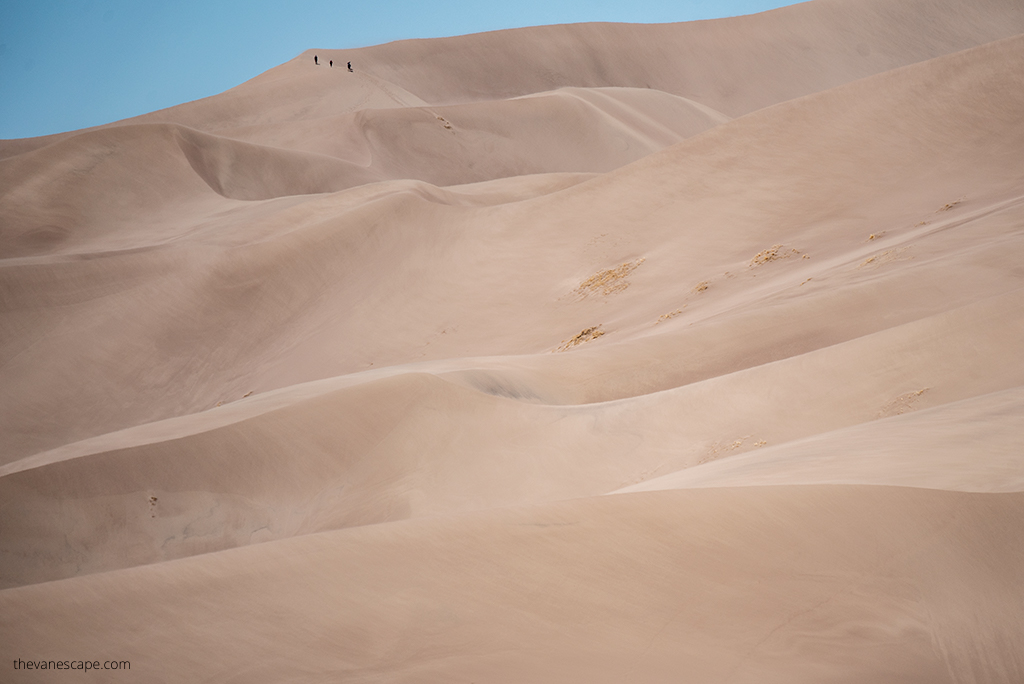
What should you bring to the Great Sand Dunes National Park?
Regardless of the season, you plan to visit the Great Sand Dunes National Park, the following tips will apply to all of them.
Protect your feet
- Good shoes which cover your feet are necessary for walking on the dunes. Sand can burn bare feet. Sand particles can cause abrasions, so wear sturdy and closed footwear and socks, whatever the season. Remember that sand surface temperatures can soar to 150°F (66°C) on sunny summer afternoons!
Water & Snacks
- Carry plenty of water. Take a large water reservoir. Walking on dunes is much heavier and more difficult than walking on hard surfaces. You walk much slower. You will be thirsty, so drink a lot. It is also a good idea to pack some electrolytes. The elevation at the Great Sand Dunes ranges from 8,000 to over 13,000 feet above sea level, so make sure to stay hydrated.
- Pack some snacks too. You can’t buy anything to eat in the park. Walking in the dunes might be tiring, so you need energy. Take energy bars or beef jerky, or other delicacies you like.
Sun, Sand & Wind Protection
- Use sun protection even in colder months. Use sunscreen SPF 50, and cover your head with a hat with the UV Protection. The addition of light-colored sand to an already hot day can dramatically increase your chance of burning. But even in the winter months, you can still sunburn in Great Sand Dunes National Park.
- It is worth keeping your shoulders covered too. A long-sleeve shirt that offers UV protection will be perfect.
- It is usually windy at the top of the dunes. So,it is worth pack something warmer to wear too.
- Moreover, the wind raises the sand, so you should wear sunglasses and a light scarf or bandana to protect your face and neck from sand particles. Sunglasses are a must-have to protect your eyes from the blowing sand and sun rays as well.
- Moreover, the differences in temperature between day and night are significant in this area, so even in summer, it is worth wearing layers and taking something warmer.
- During the summer, pack a bug spray to keep those pesky mosquitos away. They are very tiring in Great Sand Dunes.
PRO TIP: Protect your phones/cameras, car kye, and other valued items before the sand. Pack them into a Dry Bag. The last thing you want is your phone, camera, and lenses filled with sand. A Dry Bag is a great idea for keeping your items protected while admiring Great Sand Dunes.
15 Best Things To Do in Great Sand Dunes National Park
You will see the large parking lot on the left when you enter the park. It’s the main area where you can access the vast expanses of sand dunes. Here, you’ll find showers and bathrooms as well. Park your car here and enjoy the Great Sand Dunes National Park.
Depending on the season, you must cross Medano Creek, which separates the parking lot from the dunes. The most water is in May and June. Water is shallow, so you can easily cross the stream.
From the parking lot, it’s a short 0.7-mile hike to the first dune slopes. Or you can hike to the top of the taller peaks located about 1.25 miles from the parking lot.
Walk the Dunes
The best things you can do in Great Sand Dunes National Park is walking throug the dunes and exploring them. The dunes are fun to climb and hike, and it’s a great adventure because there are no designated trails. Walking in the deep sand is also a little challenging, so it’s a great workout.
The scenery is stunning due to the alpine peaks around the dunes. You can enjoy the dunes walk for an hour or a few hours, depending on your available time. Remember to take the water and prepare for the hike. There is no shade or access to water along the route.
High Dune on First Ridge is the most common destination in the dune field. It provides a great view of the entire dune field. It is about 699 feet (198 m) from base to top.
But you can hike not only in the dunes. With the forested mountains, there are plenty of wooded areas to explore as well in the Great Sand Dunes National Park. Detailed descriptions you will find on the NPS website.
Hike To The Tallest Dune In North America
The Great Sand Dunes National Park has five dunes over 700 feet tall. Not too high? Well, it’s not easy to hike in deep sand. It can take up to an average of 6 hours roundtrip to hike to the tallest dune. Climbing these massive dunes is a challenging workout. So, pack a lot of water and snacks and hike.
Hike the Star Dune
The tallest dune in North America stands at 750 feet (229m) from base to summit. It’s a Star Dune. It can be hiked from the summit of the High Dune on the first ridge. Or you can access it via its base along the Medano Creek bed. From the Dunes Parking Lot, you should hike about 2 miles (3.2 km) south down the Medano Creek bed until the massive pyramid-shaped Star Dune comes into view. Follow a ridge to its summit. There is no marked trail. So, it can take even more than 6 hours and 8 miles. Prepare for this hike correctly.
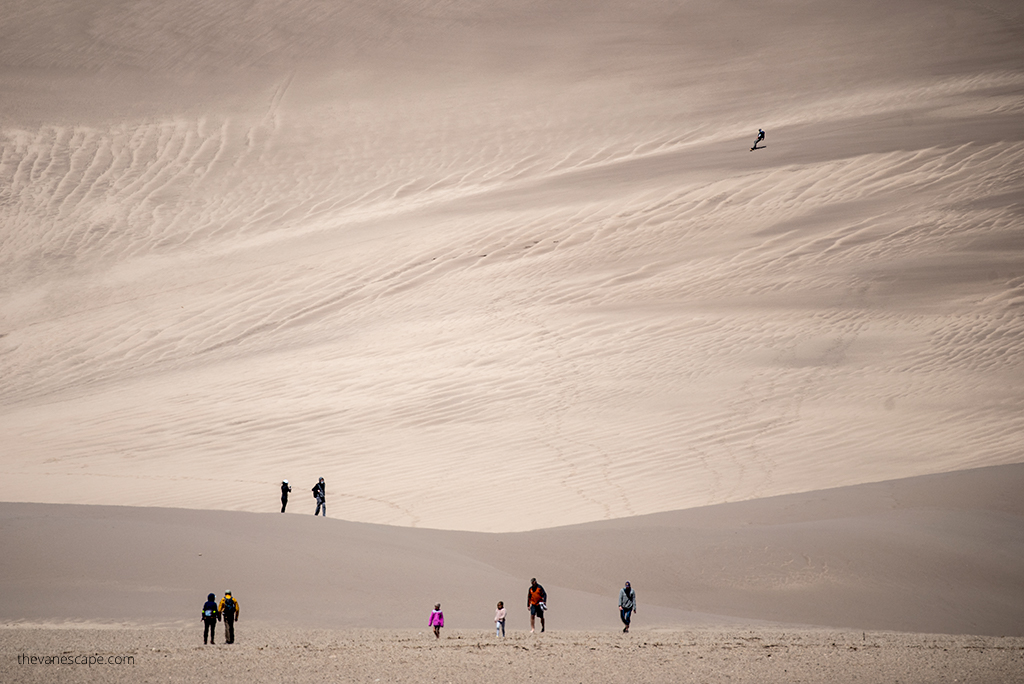
Photograph the Great Sand Dunes
One of the best things to do in Great Sand Dunes National Park is taking pictures of the sand and dunes. The particles of sand moving over the dunes are perfect for the shot. Wandering dunes create a fairy-tale landscape. The snowy peaks of the mountains provide a beautiful contrast. You’ll have the best light for your photos in the morning and late afternoon.
Try Sand Boarding & Sledding in Great Sand Dunes National Park
One of the most popular things to do in Great Sand Dunes National Park is Sand Boarding & Sledding. Surfing in the desert is a great adventure. It’s activities which offer lots of fun for families. But you should know that the surface of common snow sleds or snowboarding might be too dry for sand.
So, if you want to try sandboarding or sledding on Great Sand Dunes, you should rent special gear with the right kind of surface and a special wax finish. You can rent gear in the nearby towns of Alamosa, Blanca, or Hooper. In Alamosa, you can rent gear in Kristi Mountain Sports.
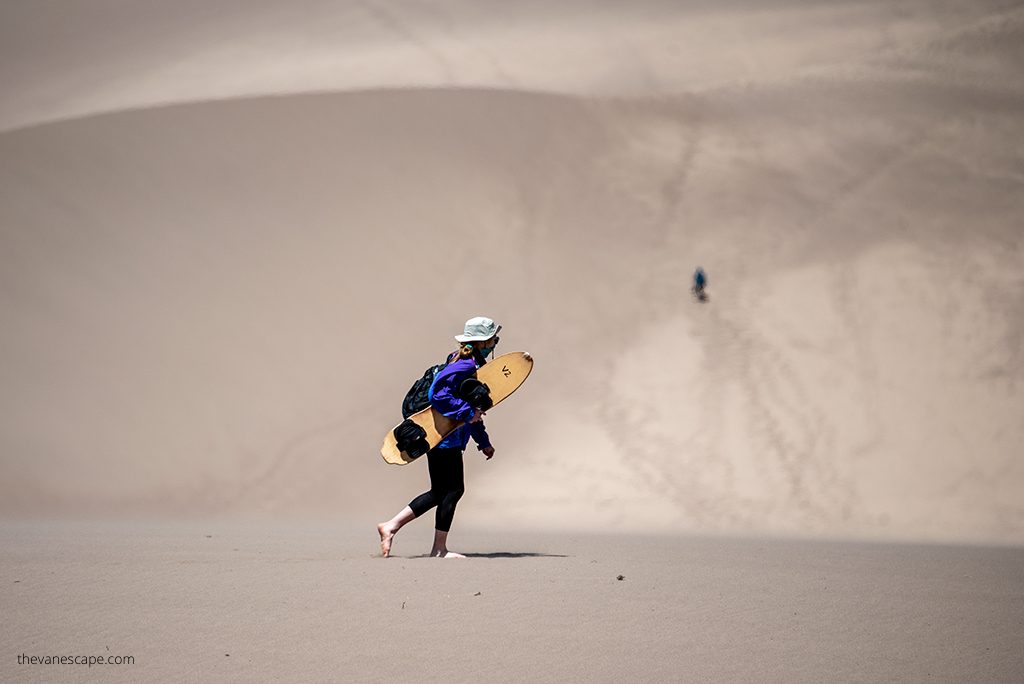
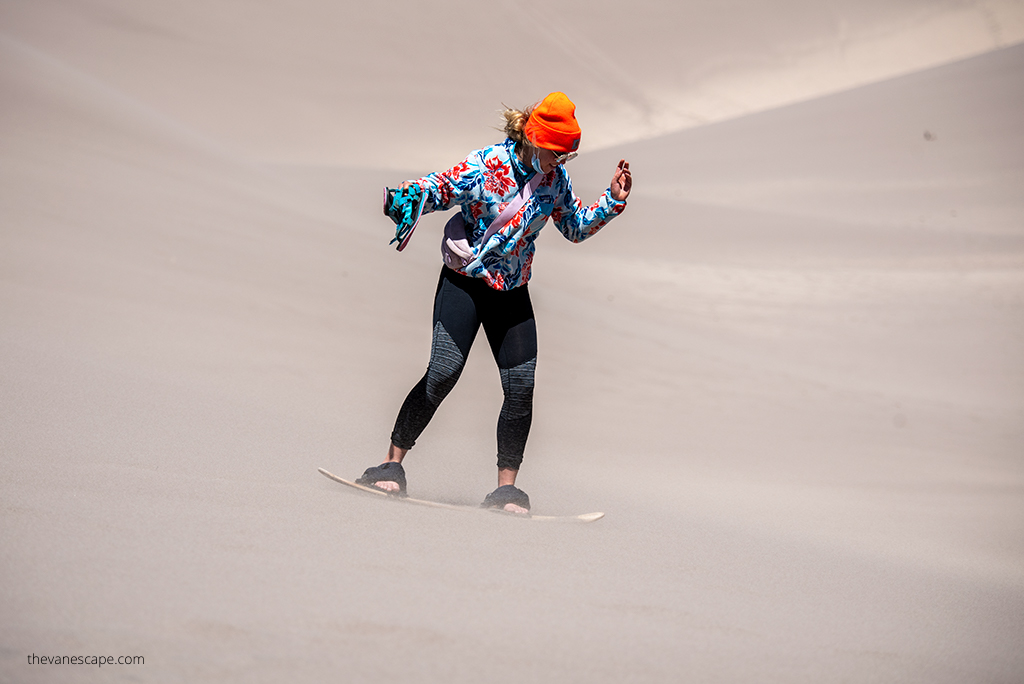
Splashing in the Medano Creek
When the snow melts from the Sangre de Cristo mountains, the Medano Creek at the bottom of sand dunes is full of water. It gives amazing contrast with the sand and mountains in the background. You can play or swim in the water. It’s shallow. It’s a seasonal stream in Great Sand Dunes National Park. Tourists enjoy surfing, skimboarding, rafting, and sandcastle building in Colorado’s Natural Beach.
But before you decide on water activities, check alerts and weather levels. The water volume is greatest in late May and June. The water might be cold. But for sure it is one of the funniest things to do in Great Sand Dunes.
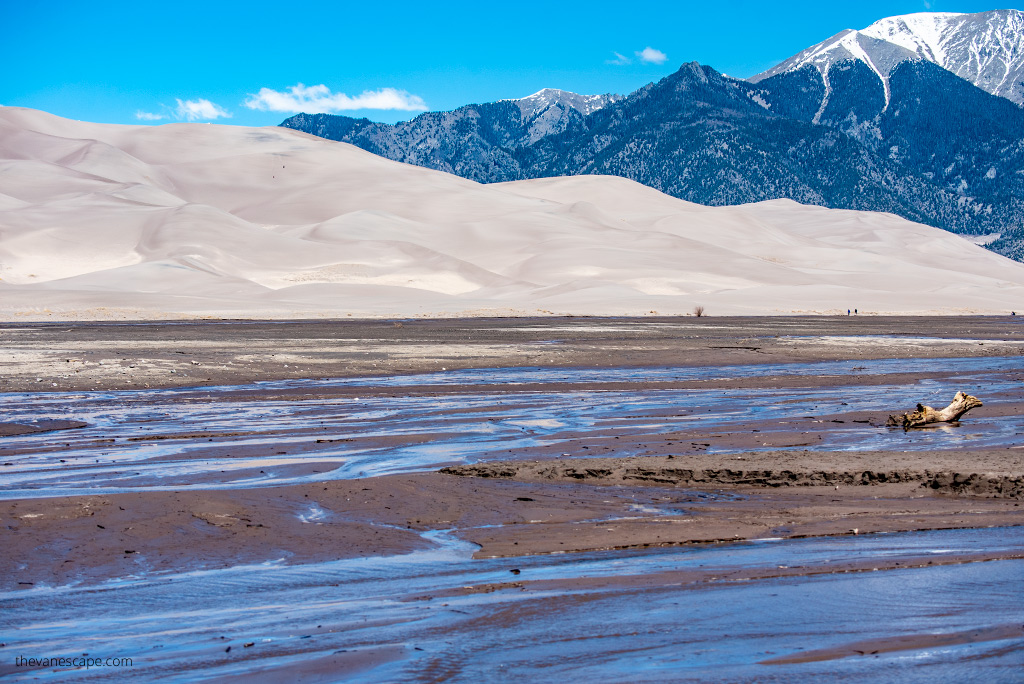
Stargaze in Great Sand Dunes
If you can, stay for a night in the park. The Great Sand Dunes National Park is renowned for being one of the best places to stargaze in the entire United States. You can see every star within the Milky Way. Tips on how to prepare to experience the stargazing night you will find here.
Admire Alpine Peaks
Great Sand Dunes National Park and Preserve are surrounded on the north, south, and east by lands managed by the US Forest Service, including the Rio Grande National Forest (west side of the Sangre de Cristos) and the San Isabel National Forest (east side of the Sangre de Cristos).
Eight 14,000′ peaks and many other peaks, valleys, alpine lakes, and streams are found within these two national forests. 14,037′ Little Bear Peak and 14,345′ Blanca Peak are two of the high peaks in the Sangre de Cristo Range near Great Sand Dunes National Park and Preserve, which you can admire during your visit.
Backpacking and Camping at Great Sand Dunes National Park
It’s also possible to camp in the park. But to camp in the backcountry, you must reserve a backcountry permit in advance through the official website Reservation.gov. Permits can be reserved 3 months in advance and are available year-round. Print your permit in advance so that you can display it in your car. Otherwise, overnight parking is not allowed in the Dunes Parking lot.
Check Free Ranger Programs
Great Sand Dunes National Park also offers Free Ranger Programs. It all depends on o the season and weather. So, the best idea is to check the schedule before your trip. There is also Junior Ranger Program in the park. It’s one of the best things to do in Great Sand Dunes if you traveling with kids.
Drive Medano Pass 4WD Road
If you have a car with 4-wheel drive, high suspension, and a lot of experience driving in extreme conditions and deep sand, you can drive Medano Pass 4WD Road. It’s one of the best adventurer things to do in Great Sand Dunes. Medano Pass Primitive Road is a rough 22-mile road connecting Great Sand Dunes with the Wet Mountain Valley and Colorado State Highway 69.
Passable only in the warmer months. This road crosses areas of deep sand, and traverses Medano Creek nine times. To do this drive, you must reduce tire pressure to about 20 psi if the sand is dry and soft. Detailed map and Medano Pass Primitive Road description mile by mile you will find here.
Hike to Zapata Falls near Great Sand Dunes National Park
Zapata Falls is a beautiful waterfall near the Great Sand Dunes National Park. Is located on BLM land south of the national park, off of Highway 150. Driving to the trailhead provides an excellent view of the entire dune field and San Luis Valley.
However, the hike to the falls requires wading over slippery rocks into a rock crevasse. It’s an easy hike. It’s only 1/2 mile one way, and you wade into a crevasse where the 30 feet high falls cascade onto a ledge. But rocks are slippery. Moreover, water may be deep and swift in early summer during snowmelt, so be careful. In winter, the falls freeze, creating an icy sculpture. We were in May, and it was still frozen.
How to get to the Zapata Falls trailhead? From the Visitor Center, drive south 8 miles, then turn left (east) onto a rough dirt road marked by a large sign. Drive 3.5 miles to the trailhead. It’s a rough road. It’s one of the best hiking trails in the area of Great Sand Dunes.
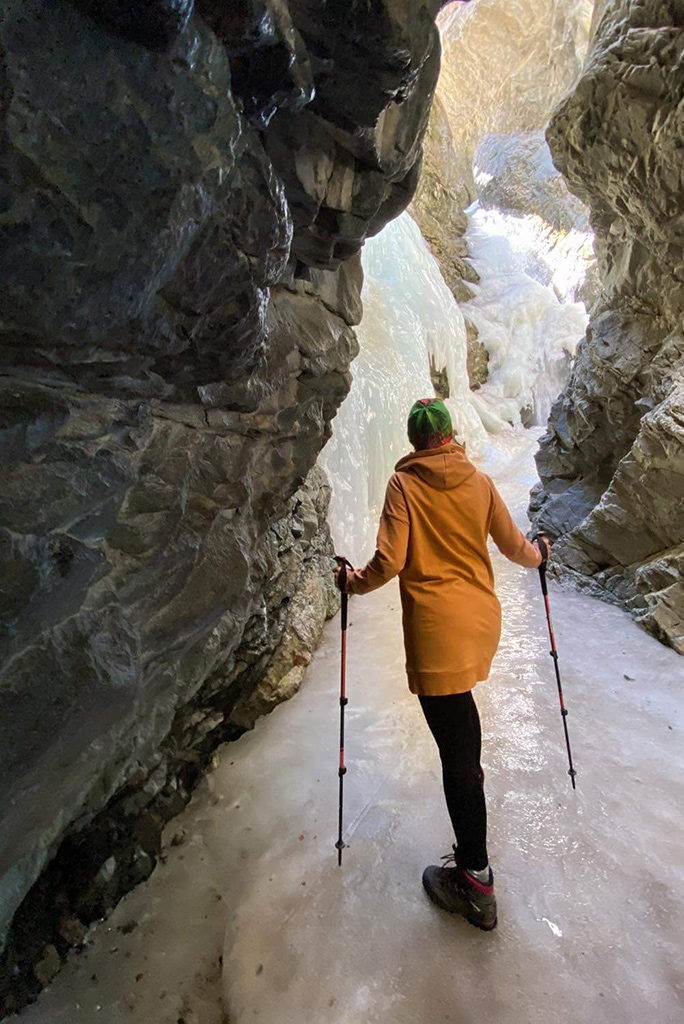
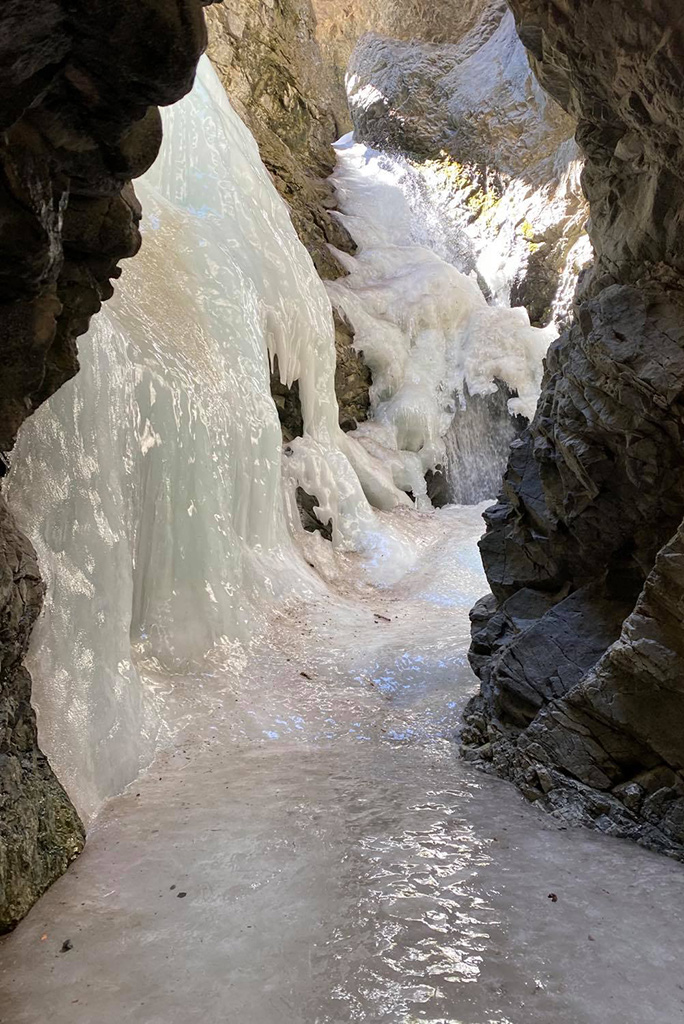
Other activities in Great Sand Dunes National Park
Other things to do in Great Sand Dunes National Park are Horseback Riding and Fat Biking. But check the rules before you go.
Admire Sandhill Crane Migration
Over 20,000 cranes spend part of their spring and fall each year in San Luis Valley near the Great Sand Dunes. After wintering in the Bosque del Apache National Wildlife Refuge in New Mexico, they typically arrive in the San Luis Valley in early February. It’s a fabulous nature spectacle.
They leave again by late March for the northern U.S. and Canada, where they raise their young. In fall, they begin to arrive back in the San Luis Valley in late September and leave by late November. The best hotspot for crane viewing is Monte Vista National Wildlife Refuge, and San Luis Lakes State Wildlife Area.
If you are a bird and wildlife photographer, you can also check other National Wildlife Refuges in the San Luis Valley area as Baca NWR, Alamosa NWR, and Monte Vista NWR.
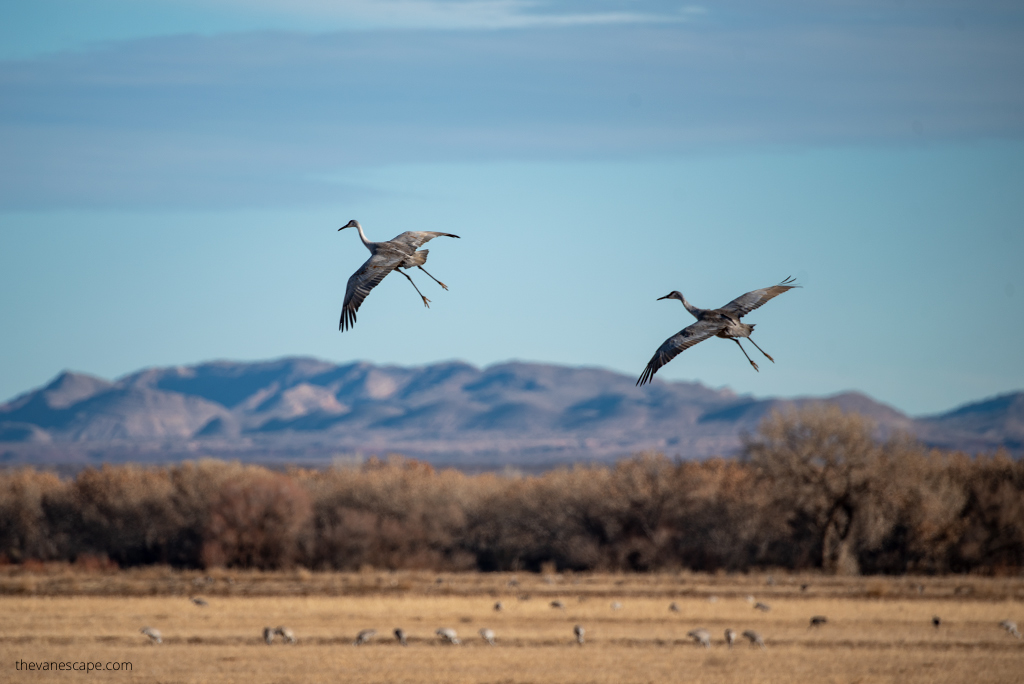
Where to Stay in Great Sand Dunes National Park?
Great Sand Dunes Camping
Piñon Flats Campground is located inside the Park. The Piñon Flats Campground is open seasonally from April 1st until October 31st. The campground offers 86 campsites. The park recommends making a reservation in advance. All sites must be reserved through Recreation.gov or by phone at 1(877) 444-6777.
Hotels near Great Sand Dunes
There are no lodging options within the national park or preserve. Lodging in the Great Sand Dunes area is pretty wide in Alamosa. In this town, you will find accommodation for each budget. Alamosa is 38 miles southwest of Great Sand Dunes National Park Visitor Center.
A great choice will be Dunes Inn Alamosa and The Sunset Inn.
